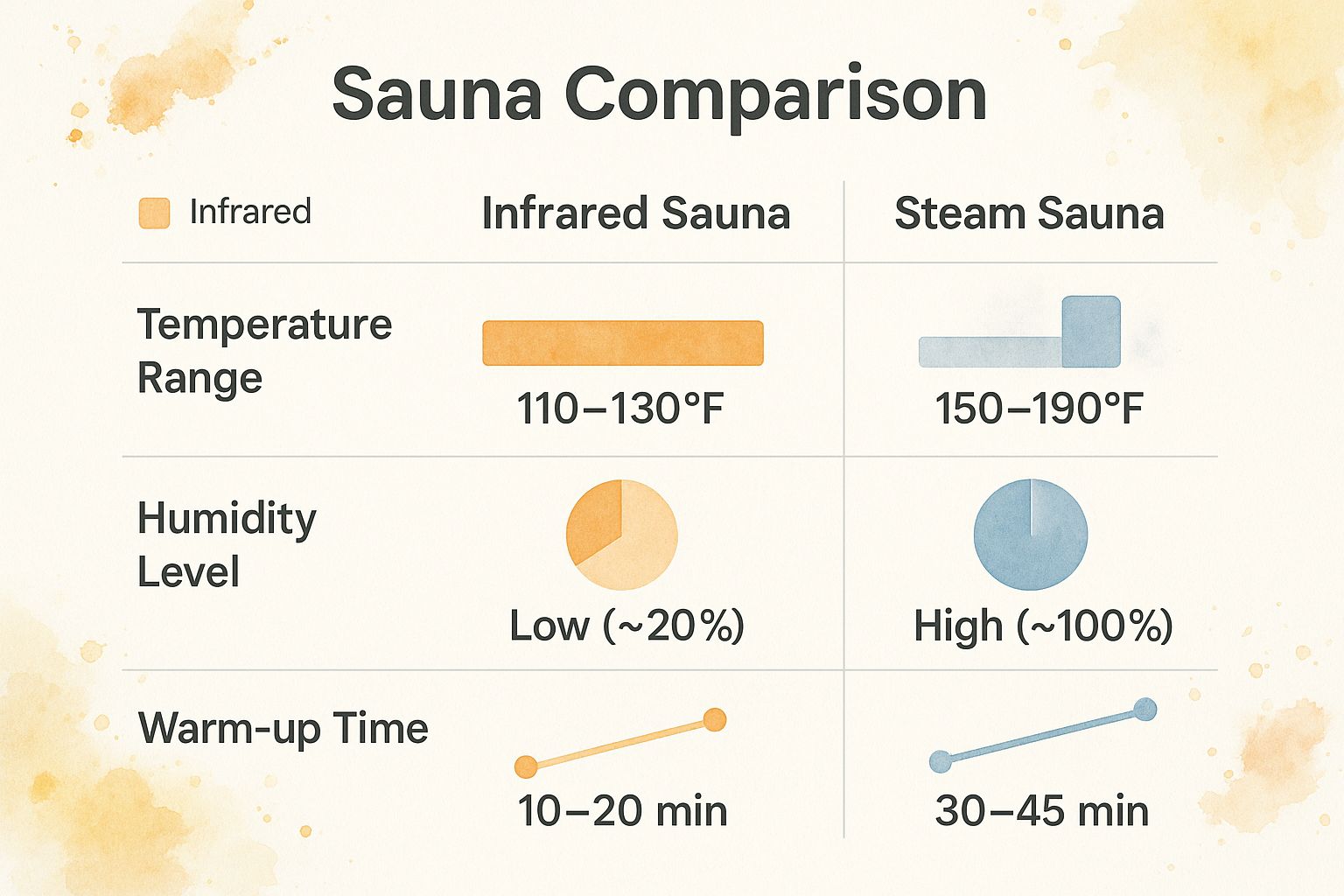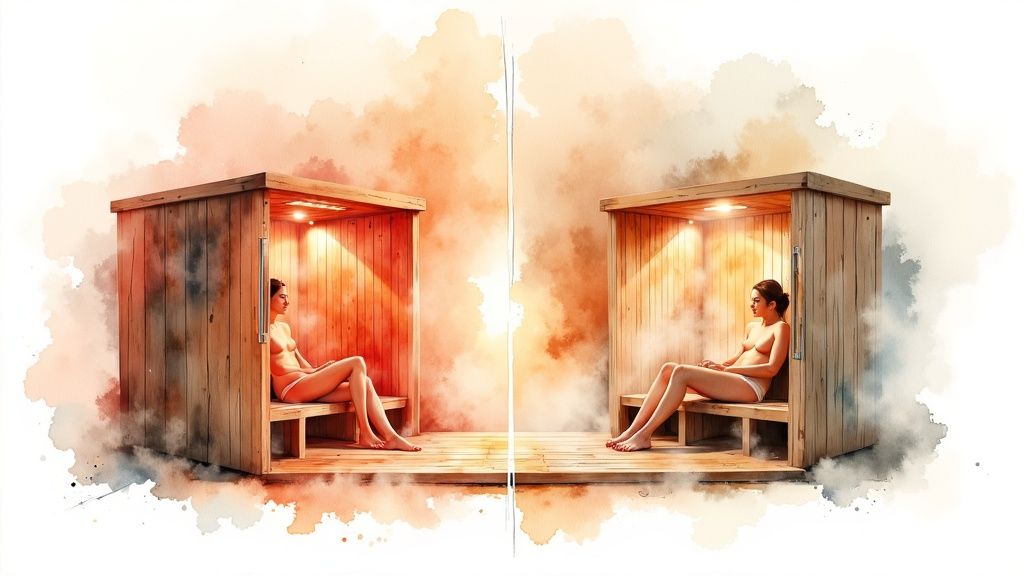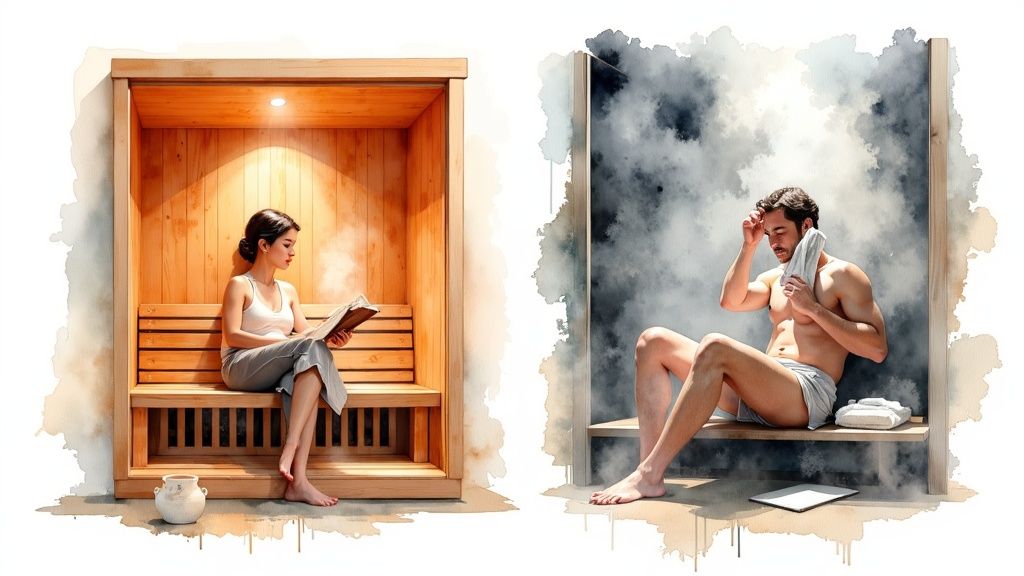
Infrared vs Steam Sauna: Which Is Right for You?
Share
When you're weighing an infrared sauna against a steam sauna, the core difference boils down to one simple thing: how they make you sweat. Infrared saunas use radiant light to heat your body directly, sort of like the sun's rays warming your skin. This creates a deep, penetrating warmth at much lower temperatures. On the other hand, a classic steam sauna (or steam room) heats the air around you with nearly 100% humidity, enveloping you in a cloud of hot moisture.
Your decision really comes down to the kind of heat experience you're after. Do you want an intense, dry warmth that feels like it's working from the inside out? Or do you prefer the feeling of being wrapped in a thick, moist heat?
Understanding the Core Differences
Choosing between an infrared sauna and a steam room isn’t just about the heating technology; it's about the entire wellness experience you want to create. Each one fosters a completely different environment, which in turn affects everything from how comfortable you feel during a session to the specific health benefits you might be chasing.
Think of it this way: an infrared sauna feels like basking in the warm sun on a cool day, while a steam room is like stepping into a hot, misty jungle. To really get a handle on which is right for you, we need to look at what makes them tick. The differences in temperature, humidity, and even how fast they heat up are what truly shape the experience.
Primary Distinctions
This quick visual breaks down the main operational differences between the two, hitting the key points of temperature, humidity, and the time it takes to get going.

As you can see, infrared saunas offer a faster, lower-temperature session. Steam saunas take a bit more time to get up to their high-heat, high-humidity sweet spot.
Key Takeaway: It’s all about the heat source and the atmosphere it creates. Infrared saunas use dry, radiant heat that warms your body directly. Steam saunas use moist, convected heat that warms you from the outside in.
To give you a clearer picture, I've put together a simple table that lays out the fundamental characteristics side-by-side. It’s a great quick reference before we dive deeper into what these differences mean in the real world.
Infrared vs Steam Sauna At a Glance
| Feature | Infrared Sauna | Steam Sauna (Steam Room) |
|---|---|---|
| Heat Source | Infrared light waves (radiant heat) | Steam generator boiling water (convected heat) |
| Operating Temp | 110–130°F (43–54°C) | 150–190°F (65–88°C) |
| Humidity Level | Low (around 20%) | High (nearly 100%) |
| Warm-Up Time | 10–20 minutes | 30–45 minutes |
| Typical Session | 30–45 minutes | 15–20 minutes |
| Energy Use | More energy-efficient due to lower temperatures and shorter warm-up. | Less energy-efficient due to higher heat and longer warm-up. |
| Atmosphere | Dry, gentle, penetrating heat. | Wet, humid, enveloping steam. |
This table provides a great snapshot of the core distinctions, but now let’s unpack what these specs actually mean for your health, budget, and daily routine.
How Each Sauna Generates Heat

When you dig into the infrared vs. steam sauna debate, the first thing to understand is how they actually get hot. It’s not just a minor detail; the way each sauna creates warmth fundamentally changes the entire experience—from the air you breathe to how your body sweats. Getting a handle on this core difference is the key to figuring out which one is right for you.
An infrared sauna works in a completely different way than you might expect. Instead of heating the air, it uses special heaters that emit infrared light. This radiant energy penetrates your skin and warms your body directly, from the inside out. Think of it like standing in the sun on a cool, crisp day—the air isn't hot, but you feel the sun's warmth on your skin.
This direct heating method is what makes the experience so unique. It delivers a deep, penetrating heat that raises your core temperature without making the surrounding air uncomfortably hot.
The Science of Infrared Radiant Heat
Infrared saunas use specific light wavelengths—near, mid, and far-infrared—to target the body in different ways. Most home units focus on far-infrared, which is fantastic for penetrating deep into your tissues and making you sweat buckets, even at lower temperatures.
Because the energy is focused on heating you instead of the entire room, infrared saunas are incredibly efficient. They operate at much cooler temperatures, which many people find allows for longer, more comfortable sessions. You can actually relax, read a book, or listen to a podcast without feeling like you're being blasted by intense heat. To get a better sense of the technology, our guide comparing infrared vs traditional sauna is a great resource.
The result is a gentle but profound warmth. Users often describe it as feeling more therapeutic and less aggressive than the "wall of heat" you get in other types of saunas.
The distinct sensory experience of an infrared sauna is a dry, penetrating warmth. It’s a subtle yet powerful heat that works on a deeper level, allowing for extended relaxation and a profuse sweat without the discomfort of high ambient temperatures.
This approach is all about physics. Infrared saunas run at lower temperatures—usually between 45–60°C (113–140°F)—but often produce a more intense sweat than hotter steam rooms. Plus, their warm-up time is incredibly fast, often just 5–10 minutes, so you can spend more time enjoying your session and less time waiting around.
The Mechanics of Steam Convective Heat
A steam sauna, which many people call a steam room, is the polar opposite. It works through convection. A steam generator boils water and pumps the hot vapor into an airtight room. The steam heats the air, and then the hot, humid air heats your body.
The defining feature here is the humidity, which climbs to nearly 100%. This thick, moisture-saturated air feels heavy and prevents your sweat from evaporating, creating a completely different kind of intense, wet heat.
Because of the extreme humidity, the air feels much hotter than its actual temperature. It’s like stepping into a tropical rainforest—a thick, steamy atmosphere that has a noticeable effect on your breathing and skin.
The heating process is simple but takes a bit more time. The generator has to boil enough water to fill the space with steam, which is why a steam sauna typically needs a warm-up period of 15–30 minutes.
The experience is powerful and all-encompassing. The heavy, moist air encourages deep breathing and you can feel the effects on your skin almost immediately, leaving it feeling cleansed and hydrated. It's a stark contrast to the dry, radiant heat of an infrared sauna.
Comparing the Health and Wellness Benefits

When you pit infrared against steam saunas, it's not a matter of one being flat-out better than the other. Both are phenomenal tools for boosting your well-being. They both get you to that deep, cleansing sweat by raising your core body temperature, which gets your heart pumping and blood flowing.
This is why, at a fundamental level, they share a lot of the same perks. You'll get a solid detoxification effect from sweating out impurities, and your heart gets a gentle workout that improves circulation. Plus, the enveloping heat is a fantastic way to tell your muscles to let go of the day's tension. The real choice comes down to the specific benefits you're after, which are tied directly to how each sauna delivers its heat.
Infrared Saunas for Deep Tissue and Pain Relief
The magic of an infrared sauna lies in its radiant heat. Instead of just heating the air around you like a traditional sauna, infrared waves penetrate your body directly, warming you from the inside out. This heat can reach up to 1.5 inches below the skin, getting right into your muscles and joints.
This is precisely why infrared has become the go-to for anyone focused on physical recovery. Think about it in these real-world terms:
- Post-Workout Recovery: If you're an athlete or just hit the gym hard, that deep heat helps flush out lactic acid and reduce muscle soreness. It boosts blood flow to those tired tissues, speeding up the repair process.
- Chronic Pain Management: For someone dealing with arthritis or fibromyalgia, the penetrating warmth can be a lifesaver. It eases joint stiffness and inflammation without the oppressive, humid heat of a steam room.
- Boosting Circulation: By warming your core first, infrared heat gives your circulatory system a more profound workout, which is great for long-term cardiovascular conditioning.
The standout feature of an infrared sauna is its direct-to-the-source heat. It’s not about enduring hot air; it's about delivering targeted, therapeutic warmth deep into your body for real relief and recovery.
Because infrared saunas run at lower temperatures, you can often stay in them longer. This extended time can be a huge plus if you're aiming for sustained pain relief or just want a longer, more meditative session.
Steam Saunas for Respiratory and Skin Health
While infrared saunas target what's underneath, steam saunas are all about the surface—your skin and respiratory system. The key here is the environment: a steam room is filled with nearly 100% humidity. This creates a blanket of warm, moist air that has its own unique therapeutic effects.
That super-hydrated air is a natural decongestant. It works wonders to loosen mucus and clear out your sinuses and lungs, making it the perfect choice for specific situations:
- Fighting Colds and Allergies: When you're stuffed up, the warm steam can soothe irritated airways and provide immediate relief from sinus pressure.
- Respiratory Support: People with conditions like bronchitis (always check with a doctor first) often find the moist air helps relax their bronchial tubes, making each breath a little easier.
That intense humidity is also incredible for your skin. The steam opens up your pores for a truly deep cleanse, and the moisture plumps and hydrates your skin, leaving you with a fresh, dewy glow.
The science backs up these distinct advantages. One study noted that while both saunas get your heart rate up—peaking around 132 bpm in infrared and 135 bpm in steam—their specialties are clear. The thick, humid air in steam saunas is superior for skin hydration and clearing congestion, which is why they’re a favorite for people with allergies. In contrast, the same research confirmed infrared’s edge in pain relief due to its deeper heat penetration. To get the full picture, you can learn more about the a sauna's physiologic impact30275-1/fulltext).
The Real-World Costs: Installation, Maintenance, and Your Budget
Thinking about bringing a sauna home? The experience itself is just one part of the equation. You also have to consider the practical side of things—your budget, the installation hassle, and the time you'll spend on upkeep. This is where infrared and steam saunas really start to show their differences.
These factors go way beyond the sticker price and will shape your total cost of ownership for years to come. Let's dig into what it actually takes to buy, build, and maintain each type of sauna.
The Initial Price Tag
Right off the bat, the upfront cost is probably the biggest financial gap between these two options. Infrared saunas are almost always sold as prefabricated kits. This makes pricing straightforward and keeps them within reach for many people. A solid one or two-person infrared unit will typically run you between $2,000 and $4,000, with larger or more advanced models costing more.
Steam saunas are a completely different animal. You're not just buying a product; you're commissioning a construction project. A steam room has to be custom-built, which means creating a fully waterproof, tiled space from the ground up. The final bill includes the steam generator, framing, special insulation, vapor barriers, tile work, and a sealed door. It's not uncommon for a professionally built steam room to start at $8,000 to $15,000 and go up from there, depending on the size and finishes you choose.
The Bottom Line: If you're looking for a predictable, lower upfront cost, infrared is the clear winner. A steam room is a serious home renovation project with a much higher initial price tag.
Getting It Set Up: The Installation Reality
This is another area where the two paths diverge dramatically. An infrared sauna is basically a piece of furniture you assemble yourself. They show up flat-packed, and with a friend and a few basic tools, you can usually have it built and ready to go in a couple of hours. Most plug right into a standard wall outlet, though some bigger models might need a dedicated circuit. It's a weekend project, not a construction zone.
Installing a steam room, on the other hand, is a job for the pros—and not just one. You'll need:
- A Plumber: To run a dedicated water line to the steam generator.
- An Electrician: The generator is a power-hungry beast that needs its own 240-volt circuit. This is not a DIY task.
- A Contractor/Tiler: The room has to be built like a fortress against moisture. Everything needs to be perfectly waterproofed and sloped for drainage to prevent serious water damage and mold down the road.
Putting in a steam room is far more invasive and time-consuming. It's a genuine construction project that will disrupt your home for a while.
Day-to-Day: Maintenance and Running Costs
So, you've got your sauna installed. What's it like to live with? Here, the differences in upkeep and utility bills become pretty clear.
Infrared saunas are incredibly low-maintenance. The dry heat means mold and mildew are non-issues. A quick wipe-down with a damp cloth after you're done is usually all it takes. They're also lean on energy use, heating up in just 10-20 minutes and running on less power.
Steam rooms require a lot more attention. That warm, wet environment is a paradise for mold and mildew if you're not on top of it.
Your routine will include:
- Daily Wipe-Downs: You'll need to squeegee or wipe down all the walls and benches after every single use to manage the moisture.
- Weekly Scrubbing: The tile and grout will need a good cleaning regularly to keep mildew from taking hold.
- Generator Maintenance: The steam generator needs to be flushed periodically to get rid of mineral buildup (descaling), especially if you have hard water.
On top of the cleaning, steam rooms take longer to heat up (30-45 minutes) and use more energy to boil water, making each session a bit more expensive. These ongoing chores and costs are a big deal when you think about your long-term enjoyment.
The In-Session Experience and Atmosphere

Forget the technical specs and health claims for a moment. When it comes to the infrared vs steam sauna debate, the decision often boils down to a single, very personal question: which environment do you actually enjoy? The feeling you get inside is what keeps you coming back, and what one person finds blissful, another might find suffocating. It’s all about matching the atmosphere to your personal wellness goals.
An infrared sauna provides a quiet, dry warmth that heats your body directly, not just the air around you. This is a fundamentally different sensation from a traditional steam sauna. People often describe it as a gentle, enveloping heat, which makes it easier to settle in for longer, more meditative sessions.
Because the air temperature stays relatively low—usually between 110–130°F—the environment is quite comfortable. You can actually do things. Many people read, listen to music or podcasts, or even do some light stretching during their 30 to 45-minute sessions. It’s a subtle yet deep heat that promotes relaxation without feeling overpowering.
The Gentle Warmth of Infrared
Think of the way sunlight feels on your skin on a crisp day. That’s the closest comparison to an infrared session. The radiant heat works its way directly into your muscles, giving you a deep, productive sweat without the challenge of breathing scorching-hot air.
This gentler approach makes infrared an excellent fit for anyone sensitive to extreme temperatures or for those who want a longer, more therapeutic escape. The goal isn't to endure the heat; it's to soak it in.
“The infrared sauna feels like soaking in the warmth of the sun. It's a peaceful, dry heat that lets me relax for a full 40 minutes, something I could never do in a traditional sauna.”
The design of modern infrared saunas often complements this vibe, turning a simple session into a full-on retreat. You can get plenty of inspiration from modern sauna room design ideas that show how to create a personal sanctuary right in your home.
The Intense Cloud of a Steam Room
Stepping into a steam sauna is a totally different ballgame. It's an immediate, full-body immersion into a thick cloud of hot, moist air. With humidity levels shooting up to nearly 100%, the experience is powerful and all-encompassing. The air is heavy with moisture, which can feel incredible for your lungs and skin.
This intense environment is really built for shorter, more potent sessions, typically lasting just 15 to 20 minutes. The main event here is deep breathing and embracing the purifying sweat that only this kind of moist heat can produce. There’s not much room for multitasking; the experience commands your full attention.
For many, that intensity is precisely the point. The blast of steam feels like a true cleanse, and the high humidity leaves your skin feeling hydrated and refreshed in a way dry heat can't.
“The steam room is a powerful, purifying cloud of heat. It’s an intense, short burst that clears my sinuses and makes me feel completely refreshed and cleansed from the outside in.”
Ultimately, the best choice comes down to the sensory experience you're after. Do you want a long, meditative session wrapped in a gentle, penetrating warmth? Or do you crave a short, powerful blast of immersive, moist heat? Figure that out, and you’ll know exactly which sauna is right for you.
How to Choose the Right Sauna for Your Lifestyle
When it comes to the infrared vs steam sauna debate, there’s no single "best" choice—only what's best for you. The right sauna really depends on your health goals, how much space you have, your budget, and the kind of experience you're after.
Think about why you want a sauna in the first place. Are you trying to soothe sore muscles after a workout? Looking for respiratory relief? Or just want a peaceful escape? Pinpointing your main motivation is the first step to making the right call.
Your Primary Health Goals
Let's get practical and match the sauna to your wellness goals. What you're trying to achieve will often point you clearly in one direction.
-
For the Athlete Focused on Recovery: If your main reason is easing muscle soreness and joint pain, an infrared sauna is your clear winner. Its radiant heat gets deep into your muscle tissue, boosting circulation and speeding up recovery in a way that steam just can't replicate.
-
For the Spa Enthusiast Seeking Skin and Respiratory Health: If you're chasing that home-spa feeling and want glowing, hydrated skin and clear sinuses, a steam sauna is the perfect fit. The intense, near-100% humidity is second to none for opening pores and providing powerful respiratory relief.
Starting with your primary goal is the most straightforward way to narrow down your options.
Space, Budget, and Personal Preference
Beyond the health benefits, the day-to-day realities of space, cost, and personal taste are just as important. One option is a simple addition to a room; the other is a full-blown construction project.
Infrared saunas are generally the more practical choice. Most are freestanding units that are simple to assemble and much easier on the wallet, making them ideal if you're working with a smaller space or a tighter budget. They're also perfect for people who enjoy a longer, more meditative session in a gentler, dry heat.
On the other hand, a steam sauna is a bigger commitment. It almost always requires custom installation, complete with dedicated plumbing and electrical work, which means a higher upfront cost and more involved maintenance. This is the best route for someone designing a dedicated wellness area who truly loves the intense, all-encompassing feeling of moist heat.
Situational Recommendation: If you’re a renter or just have a spare corner in a guest room, a plug-in infrared sauna gives you fantastic benefits with almost no commitment. But if you're building a new home or remodeling a master bathroom and want a true spa-like atmosphere, a custom steam room is a luxurious and powerful upgrade.
Ultimately, your lifestyle will decide the winner. For convenient, deep-tissue therapy, go with infrared. For an immersive, humid experience that prioritizes skin and respiratory health, steam is the way to go.
Still on the Fence? Let's Tackle Some Common Questions
Even after a side-by-side comparison, it's natural to have a few questions rolling around in your head. Let's clear up some of the most common things people ask when choosing between an infrared and a steam sauna.
Can I Get the Same Detox Benefits in Both?
Absolutely. The main driver of detoxification in a sauna is sweating, and both will make you sweat—a lot. Sweating is your body's natural way of flushing out impurities, and both infrared and steam environments get the job done effectively.
Some infrared enthusiasts point to studies suggesting its deep-penetrating heat might help release toxins stored in fat cells. While that's an interesting point, the core benefit of a deep, cleansing sweat is powerful in both. It really boils down to how you prefer to get there: with the gentle, radiant heat of an infrared sauna or the all-encompassing humidity of a steam room.
Key Insight: Detoxification comes from sweating. Both sauna types trigger a deep sweat, so they're equally effective for this benefit. The difference is the experience of the heat, not the cleansing result.
Is One Sauna Type Safer Than the Other?
When used correctly, both infrared and steam saunas are perfectly safe for most healthy adults. The universal rules always apply: drink plenty of water, don't overdo your session time, and pay attention to how you feel.
That said, there are a few nuances. Infrared saunas run at lower air temperatures, which can feel more comfortable and less overwhelming, potentially reducing the risk of overheating for people who are sensitive to intense heat.
Steam saunas, by their nature, have very hot surfaces and produce steam that can scald if you're not careful. It’s essential to be mindful of your surroundings. And, of course, anyone with pre-existing health concerns like heart conditions or blood pressure issues should always talk to their doctor before starting any sauna routine.
How Do These Compare to a Traditional Dry Sauna?
Great question. The traditional Finnish-style dry sauna is the third major player here. It uses a stove to heat rocks, creating a room with extremely high temperatures (160–200°F) and very low humidity.
Think of them this way:
- Traditional Sauna: Intense, dry heat. Like a desert.
- Steam Sauna: Intense, wet heat. Like a tropical jungle.
- Infrared Sauna: Gentle, radiant heat. Like standing in the sun.
Ultimately, your choice depends entirely on what kind of heat experience you're looking for. Do you crave that classic, scorching dry heat? Or do you prefer the enveloping moisture of a steam room or the deep-penetrating warmth of an infrared session?
Ready to create your perfect home wellness sanctuary? Explore the curated collection of premium saunas and home furnishings at Fluent Trends. Find the ideal match for your lifestyle and elevate your daily routine.
